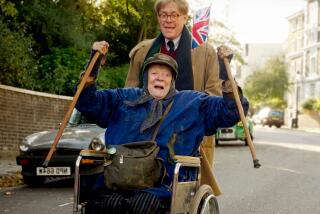One Woman Takes On a City’s Voices : THE REVIEW : ‘Twilight’ Tries to Shed Light on ’92 Riots
- Share via
Like the sprawling polyglot metropolis it takes as its topic, Anna Deavere Smith’s brilliantly crafted “Twilight: Los Angeles, 1992” is a triumph more of style than of substance. It’s a striking show filled with virtuoso artistry and compassion, and a courageous attempt to make sense out of the worst urban riots in recent history.
Smith’s work is the much-anticipated result of an ambitious undertaking. Commissioned by the Mark Taper Forum, she spent more than nine months in the field, interviewing some 175 Angelenos and others about last year’s riots. She’s been aided by a team of five dramaturges and masterfully directed by one of the American stage’s best, Emily Mann.
The format is simple: Smith takes excerpts from her interviews and reproduces her subjects’ words and mannerisms verbatim in a phenomenal display of mimetic skill. The 26 interviewees in the show include Korean-American victims of violence, cops, jurors in the Rodney G. King trials, present and ex-gang members and such well-known figures as Daryl F. Gates and Reginald (Reggie) Denny.
Yet no matter how elegant the patina, “Twilight: Los Angeles, 1992” doesn’t quite pack the emotional punch that it should. It also falls short of the analytical task it sets for itself. Ultimately, there’s less to this one-woman show than meets the eye.
Smith first gained widespread acclaim last year, when her “Fires in the Mirror: Crown Heights, Brooklyn and Other Identities” played New York’s Public Theater. (It also recently aired nationally on PBS.) The Taper’s Gordon Davidson saw the piece--which examined the 1991 Crown Heights clash between African-Americans and Hasidic Jews--and soon after the riots occurred set Smith to the task of creating a similar work on the L.A. riots.
Capturing polymorphous L.A., though, is a much more complex task than delineating the two sides in the Crown Heights conflict. On one level, Smith has risen to this Herculean challenge, metamorphosing into people of various ages, backgrounds and linguistic bents, and confirming her reputation as the contemporary stage’s most transfixing channeler. She conveys a world of experience in a single gesture; we recognize ourselves in strangers’ anecdotes.
When Smith becomes Mrs. Young-Soon Han, for example, she amply conveys the conflicted feelings of rage and empathy this former liquor store owner feels toward L.A.’s African-Americans.
Yet “Twilight” as a whole is missing something emotionally. The show, which is not a comedy, nonetheless connects with its audience primarily through laughter. Smith has got countless quirky mannerisms down cold. The humor, though, sometimes comes at her subjects’ expense. Or worse, it is irrelevant, distracting.
The high point of Denny’s story, for example, is his recollection of waking up in the hospital only to find Jesse Jackson and Arsenio Hall waiting to pay their respects. And in one of “Twilight’s” best moments, Smith as Maria (a.k.a. Juror No. 7 in the federal trial) recounts hilariously the petty bickering among her fellow jurors. Her account nails on the head how self-involved Angelenos (or anybody) can be, but it doesn’t shed any new light on L.A.’s rifts.
“Fires in the Mirror” moved its audience to sobs and catharsis; “Twilight” amuses and bemuses. With only a handful of exceptions, Smith keeps us distant from the tragedies. The stories in “Fires” built upon each other to cumulative visceral effect. The L.A. stories remain a succession of snapshots.
“Twilight” isn’t just emotionally unengaging, it’s analytically shallow. Politically, Smith’s message seldom transcends the rhetoric of race relations--its posture ranges from the militancy of a “Free the L.A. Four” to a moderate plea along the lines of Rodney G. King’s famous “Can we all just get along?” The characters she has placed in the role of a political chorus--former Black Panther Party chair Elaine Brown and a U.S. representative of El Salvador’s leftist F.M.L.N.--argue against the most self-destructive forms of revolutionary violence, but fail to offer counter strategies.
“Twilight” depicts racial politics as though they exist in a vacuum. The economic apartheid and decline that contributed to the riots is never discussed. Smith’s analysis is of a sort that keeps groups apart. It is not what you’d expect from an actress- auteur who writes in the program that she’s “interested in . . . our current challenge to find new and creative ways to negotiate racial and ethnic difference.”
What’s missing are voices of reason from people who have given serious thought to the political economics of Los Angeles. The only person included here who might have been able to do that--Stanley K. Sheinbaum, former president of the L.A. Police Commission and longtime force in liberal politics--is shown here just as an anecdotal caricature.
Still, the craft is first-rate. Robert Brill’s minimal set features chairs and tables strewn about the playing area, a back wall bank of video monitors and screens hanging from the ceiling on either side of the stage. Candice Donnelly’s astute costumes, Allen Lee Hughes’ painterly lighting and Lucia Hwong’s evocative incidental music weave it all together.
* “Twilight: Los Angeles, 1992,” Mark Taper Forum, 135 N. Grand Ave., downtown. Tuesdays-Saturdays, 8 p.m. Saturdays & Sundays, 2:30 p.m.; Sunday, July 18, 7:30 p.m. Ends July 18. $26-$32. (213) 365-3500. Running time: 2 hours, 10 minutes.
Conceived, written and performed by Anna Deavere Smith. A Mark Taper Forum production. Directed by Emily Mann. Set by Robert Brill. Costumes Candice Donnelly. Lights Allen Lee Hughes. Original music Lucia Hwong. Sound Jon Gottlieb. Multimedia design by Jon Stolzberg.
More to Read
The biggest entertainment stories
Get our big stories about Hollywood, film, television, music, arts, culture and more right in your inbox as soon as they publish.
You may occasionally receive promotional content from the Los Angeles Times.










